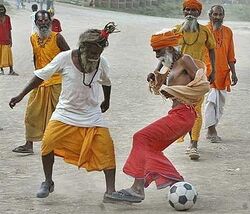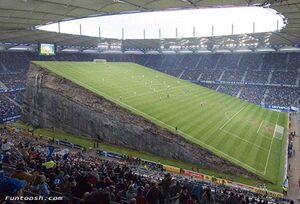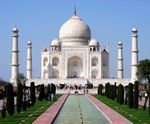Football in India
Football is one of India's most popular sports, next to cricket, lagori, kunte bille, hide-and-seek, and hockey. It was invented in 1945 by disgruntled rejects from the Indian cricket team. The game is played all over the Indian subcontinent and is gaining popularity in the motherland, England.
History[edit]
As the cricket-crazy British ruled India, the colonial subjects had little or no opportunity to either bat or bowl during matches. Fielding and substitute running were the only two roles assigned to the Indians, as the masters were never in the mood to chase after balls or get their Manchester-produced kit all sweaty.
Utterly disappointed by the lack of sportsmanship in the game, one hundred million irate local cricketers started the Non-Cooperation Movement, in which fielders refused to budge during games. The Movement led to the Quit India Movement, wherein all indigenous cricketers threatened to leave their home country unless the British Sports Ministry made a reservation for one-third local batsmen and bowlers. After numerous hunger strikes and walkouts, the government relented to a 10% indigenous quota. This ruling failed to appease the striking players and led to a total boycott of the game by Indians. Two hundred million Indians left the country for the West Indies and Canada.
In 1945, a 20,000-strong procession began a protest march in Delhi. They kicked a cricket ball wildly as a symbol of disdain for the game of cricket. Two hundred people were trampled to death as a result of a stampede caused by the crowd's frantic movements. To prevent further mishaps, their leaders devised a rule that each marcher could kick the ball only once.
The protest marches lasted two months, but participants could not get over the habit of kicking any round object. A union of ball-kicking addicts was found on 24 December 1945. The Union devised a code and instituted the Indian Kickball Association League. The word Kickball was promptly changed to Football, prefixed by Indian to avoid confusion with American football and football.
Rules[edit]
The rules and objectives of the game are uncannily similar to American Soccer and British Football. The Indian Football Association is particular about the settings of the playing surface and conditions of a match day. The standard playing field should strictly be a flat plane with a ratio of 80:20 of mud/dust to grass. The optimal match-day temperature is 35°C. (95°F.), with humidity not less than 89%. The objective of the game is to kick a roundish object, measuring not more two times smaller than the tallest player among the starting eleven, into a rectangular bamboo post whose height and width is inversely proportional to the income to the football association.
Use of non-Indian players is restricted to those whose sinuses can tolerate the breathing of hot dust for two hours.
A player committing a foul is cautioned by an off-white colored card. A more serious offense or a second off-white card is awarded the white card. Receiving a white card causes immense shame to the receiver, as it implies that the player is still a slave of the white race. Match duration is 90 minutes, but may be shortened on a signal by the local politician. If a knockout match should be tied at full time, the team facing the sun is declared the winner.
Idiosyncrasies[edit]
First and foremost, footwear is optional. The number of players is fixed at 20% of the population of the host city/town. Indian football matches have featured as many as 200 players. Dribbling and running after the ball are rare occurrences. Heading the ball has occurred only seven times in the last 65 years, as turbans and warrior headgear impede this play. Chai tea rejuvenates players before and after the game. Chewing of gum is banned in all games. It is replaced by the chewing of Paan, a cocktail of leaves, lime, betel nut, and tobacco leaves. Eunuchs are used as cheerleaders and can also cast spells on opponents.
Brawls and fan fights usually involve the use of cricket bats and hockey sticks as weapons, though forceful spitting of paan on opponents inflicts greater pain.
Domestic competitions[edit]
The Football Association holds two annual nationwide tournaments:
- The Duran Durand Cup is restricted to wealthy clubs. These are knockout matches and are held over a year due to the small number of days sufficiently sweltering to meet Indian Football Association standards. The duration of the tournaments may be extended as the situation demands. The current prize money is 200,000 Rupees ($4000) for the winner, 14,000 for the loser and nothing for the rest. In fact, the non-finalists have to pay a loser's fine of 30,000 Rupees each to the Football Association. The tournament was not held in the years 1981, 1987, 1990, 1995, 2001, 2004 and 2007 because the previous years' losers refused to pay the penalty fees.
- The Saint Tush Trophy is for all other clubs. The trophy is made from scrap metal with a brass coating. There is no prize money, since it is an interstate competition.
Popular clubs[edit]
The two most successful clubs in Indian football are:
- Mohan Began, so named as they began the art of playing the game in the country; and
- Fist Bangal fc, named thus as a tribute to the game of fist-ball. Their signature kickboxing style has been the secret to their success, whenever they can secure a refereeing crew reluctant to flag hand contact.
Other clubs that have managed to win national accolades are Punjabi Bankers, Jay's City Frock Wearers F.C., Mama-Miya Sporting, Shillong Last-long, Tempo, Sa-Re-Ga-Ma Cowboys, Train-spotting Club of Goa, Chachi and Brothers, and Manchester Automobiles United F.C.
See also[edit]
| ||||||||||||||||||||||||||||||||




